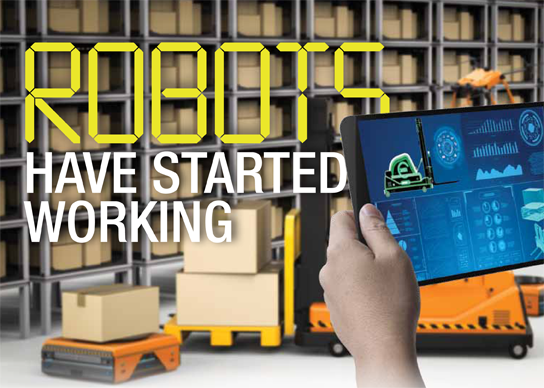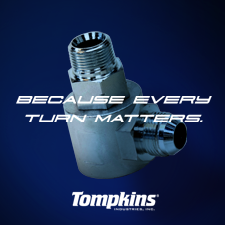Robots have started working

by Dick Friedman
At last, some distributors have started using “robots” in their warehouses, but usually not to replace humans. The robots work alongside humans that have “programmed” them, and are termed “collaborative robots” or “cobots.” They are being employed because on the one hand the cost of these robots has decreased. On the other hand, the cost of overtime has skyrocketed because many distributors can’t find enough people to fill all sales orders within straight-time business hours; not at any wage that would not upset the overall warehouse wage structure. And in this very-low-unemployment economy, even paying overtime wages has not stopped workers from leaving for easier, more satisfying warehouse jobs. The costs of recruiting and training new workers adds to the cost of employing people, and helps to sometimes justify this form of automation, which is now easier to program, and so more flexible.
Robots Walk, People Don’t
The most frequently used type of automation is an “autonomous mobile robot (AMR),” aka a “mobile collaborative robot.” Think of a battery powered four-wheel cart that wirelessly drives itself via an onboard computer that steers the cart along a path that depends on the transmitted destination and a stored map of the warehouse layout and what item is stored in which specific location. No wires are buried in the floor. For example, if all the cartons of items, such as fasteners, needed for an order have been placed on the cart by a human, he/she would use a wireless device to instruct the computer to direct the cart to begin travelling, alone, to the staging or loading area. The picker would then walk to the aisle and bay where the first item for the next order is stored, and he/she would be met there by an autonomous (perhaps) empty cart that was directed there based on transmitted data for the next order.
As the cart travels, onboard sensors detect people and objects that must not be touched; the cart would stop or change direction. Signals from transmitters inform the computer of any obstacles that are not permanent, such as a pallet recently placed in the travel path (as detected by stationery sensors). The programming can involve instructing a particular cart to travel, today, to a particular section of the staging area. Tomorrow, the cart could be instructed to travel to a different section.
By eliminating much of the walking that pickers would do, the AMR greatly increases the productivity of pickers, so all orders to be shipped/delivered in a work day can be filled with much less overtime; the pickers are happier because their feet don’t hurt as much, and they can spend more time picking accurately. Amazon employs thousands of robots that look like flying saucers, and that slide under wheeled portable shelving units that have been loaded with product, then elevate the units and transport them to the next stage.
Robots Pick, People Not Needed
Less frequently used than an AMR is a “piece-picking arm.” Think of the raised arm on the Statue of Liberty; an automated arm looks like a two-piece arm with an elbow. But instead of the lower portion of the arm being attached to a shoulder, it is attached to a heavy base. At the top end of the arm is a claw, like a hand, but with only four fingers or some other tool for grasping. The lower arm is in a vertical position when at rest, but can tilt off the vertical axis and rotate around the base as needed to pick or place. The arm can reach out or up or down to pick a piece or carton, or place a piece or carton. Some piece-pick arms are stationary and some are mobile (as the base travels); some bases can elevate (to reach higher shelves) and some can’t.
Cameras, sensors and bar code readers, all coordinated by special software, enable the arm to “see” where to pick an item and where to put an item; and to recognize if the item to be picked is not in the designated slot. The more advanced arms use software to learn and improve. For example, they can learn about the shape and location of a particular item, and store that data so future picks (or puts) occur faster.
Piece-picking arms can be programmed to pick items from a shelf to a tote or a cart of some form or programmed to pick from an open carton (opened by a human) and put away the item in a designated slot (such as pick a pack of twist-drill bits). Sensors on the arm enable it to avoid hitting objects and people that should not be in the arm’s path.
Piece-pickers can replace humans, but only for handling small, lightweight items, so for most distributors, some human pickers would still be needed. Collaborating humans would not have to work as long and could concentrate on accurately picking the larger items, such as a drum of industrial degreasing chemical.
Affordable Cost?
One reason these robots have decreased in cost is that the newer ones are less expensive to manufacture and maintain because they cannot carry as much weight or move/execute as fast as “industrial strength” robots (such as those used in auto manufacturing plants). Although they cannot be used for heavy or oversized items, cartons or boxes, today’s robots can still dramatically increase productivity and generate the cash savings described at the beginning of this article.
No matter what a cobot can or cannot do today, as with most technologies, future generations will do more and cost less. But for many distributors, especially those having trouble profitably fully staffing the warehouse, now is the time to determine if some form of automation should be acquired.
Warehouse Error Rate Must be Low
In the world of software, the term GIGO means Garbage In Garbage Out, and because the robots in question are controlled by software, they should not be considered until warehouse performance is at a very high level. This means that root causes of warehouse problems should be overcome so that picking accuracy is at least 99.9 percent because there are almost no “can’t finds”; and that picker productivity is very high because less time is being wasted finding the “couldn’t finds.”
 Dick Friedman helps fastener, tool, industrial and MRO distributors prevent warehouse mistakes that lose sales and customers, and helps determine which form of automation would be practical and cost-justified. He has even helped distributors increase warehouse accuracy where bar code scanning has not achieved a high level of accuracy. Dick does not sell automation, systems, software or warehouse technology or equipment; he has engineering and MBA degrees, and is a Certified Management Consultant. Contact him via www.GenBusCon.com for a FREE consultation or more information.
Dick Friedman helps fastener, tool, industrial and MRO distributors prevent warehouse mistakes that lose sales and customers, and helps determine which form of automation would be practical and cost-justified. He has even helped distributors increase warehouse accuracy where bar code scanning has not achieved a high level of accuracy. Dick does not sell automation, systems, software or warehouse technology or equipment; he has engineering and MBA degrees, and is a Certified Management Consultant. Contact him via www.GenBusCon.com for a FREE consultation or more information.
This article originally appeared in the May/June 2019 issue of Industrial Supply magazine. Copyright 2019, Direct Business Media.















